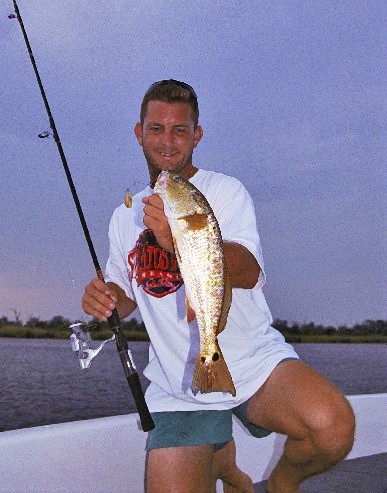A new spin on redfish
Hooking hungry reds with a bass-fishing favorite

Given the popular “crossover” movement between bass and redfish, tackle boxes for both are looking increasingly similar. One of the most versatile and effective options to be found in either box is the spinnerbait.
For one thing, spinnerbaits have always been great search baits for locating fish in a variety of habitats. Southern Louisiana redfish anglers, often facing muddy water, have long valued the spinnerbait’s knack for attracting reds in low-visibility scenarios. Bass tournament anglers, fishing estuaries like the Mississippi River delta, frequently lament burning time on redfish that can’t resist flashing blades and pulsating skirts.
Out-of-towners fishing Bayou State waters typically leave with an armful of local spinnerbaits and plans for home-water applications. As anglers and manufacturers key in on this niche bait, however, saltwater spinners are becoming more available beyond Louisiana borders.
Reds readily gobble up safety-pin-style baits common to bass anglers, but saltwater anglers typically use inline spinners or Beetle-Spin-type models. The former mounts a single blade along with brass beads or a bullet weight on a stiff wire stem, connected to a hook fitted with a soft-plastic tail. The latter most closely resembles the safety-pin style, but instead of a skirted head rigidly affixed to the lower arm, the wire clips interchangeably to the eye of a jighead with a blade dangling from the opposite arm.
Both offer the flexibility of experimenting with plastic-tail color, size and shape, while Beetle-Spin-type baits, or harness models, also allow you to change blades and jigheads to match depth and clarity. With either, a redfish has no leverage points from which to dislodge the hook.
When selecting blade styles, remember Colorado blades create the most water displacement, which means maximum vibration for redfish to detect. Willow-leaf blades are better for squeezing through tight spots, like openings in grass lines. For bodies, scented soft plastics are effective, especially in low-visibility conditions.
No doubt, saltwater spinnerbaits maximize your options, but good design isn’t all you need – your bait has to be tough enough to handle a tough customer. Bass anglers will attest that a redfish’s powerful jaws and throat crushers will mangle most freshwater spinnerbaits. Therefore, those made for saltwater species include stout stainless steel or titanium arms designed to endure a redfish assault.
Traditional bass retrieves, such as crank-and-pause, slow-rolling and jigging, can all produce redfish strikes. In the majority of cases, though, all you need to do is cast and reel. For redfish, it’s a bottom-line world: a hungry fish sees, hears or feels something that appears edible, and he’s going to clobber it. Some surmise that a spinnerbait’s sound and vibrations mimic a fleeing crab, so don’t hesitate to toss your lure right onto the mud, rocks or oyster shells to simulate a scampering crustacean.
Wal-Mart FLW Redfish Series competitor and Louisiana guide Anthony Randazzo said the weight of a saltwater spinnerbait affords him a broad spectrum of unorthodox casting angles that often allow him to reach reds on the move.
It’s not a new concept, but putting a new spin on a venerable old bait will increase redfish catches.